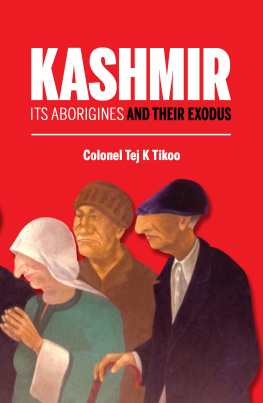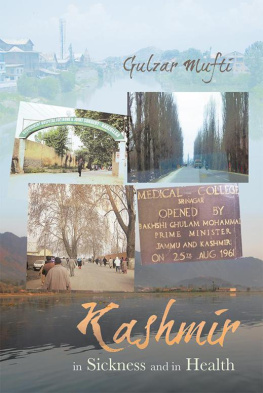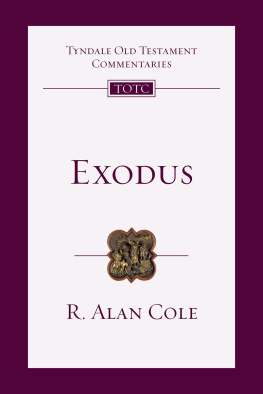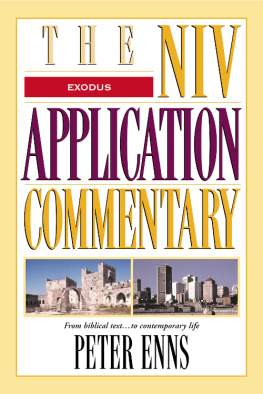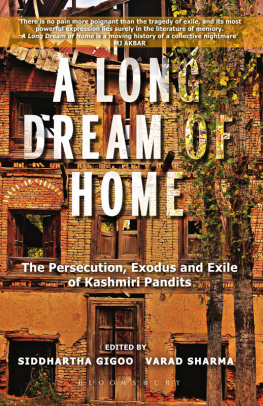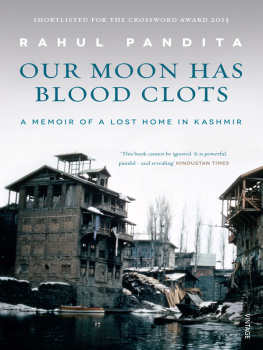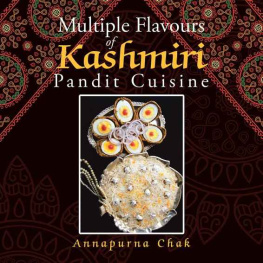| Kashmir: Its Aborigines and Their Exodus |
| Col Tej K Tikoo |
| Lancer Publishers LLC (Jul 2013) |
|
| Rating: | **** |
| Tags: | India, Kashmir, Genocide, Hindu, Non-Fiction |
| Indiattt Kashmirttt Genocidettt Hinduttt Non-Fictionttt |
Exodus of Kashmiri Pandits from Kashmir in 1989, was their seventh such exodus since the arrival of Islam in Kashmir, in the fourteenth century.
This was precipitated by the outbreak of Pakistan-sponsored insurgency across Kashmir Valley in 1989. The radical Islamists targeted Pandits - a minuscule community in Muslim dominated society, creating enormous fear, panic and grave sense of insecurity. In the face of ruthless atrocities inflicted on them, the Pandits sole concern was ensuring their own physical safety and their resolve not to convert to Islam.
Over 350,000 Kashmiri Pandits were forced to flee en masse leaving their home and hearth. This was the single largest forced displacement of people of a particular ethnicity after partition of India.
Pandits travails did not end with the exodus. The obstructive and intimidating attitude of the State administration towards the Pandit refugees, made their post-exodus existence even more miserable. The Government at the Centre too remained indifferent to their plight.
This book traces the Pandits economic and political marginalization in the State over the past six decades and covers in detail the events that led to their eventual exodus.
In the light of ethnic cleansing of Pandits from the Valley, the book also examines some critical issues so crucial to Indias survival as a multi-cultural, liberal and secular democracy.
About the Author
Col. Tej Kumar Tikoo (Retd), PhD, was born at Srinagar (Kashmir) on April 15, 1950.
After completing his school and college education at Srinagar, he joined the Indian Army, being commissioned into 1st Battalion of the newly raised Naga Regiment on August 22, 1971. Soon thereafter, he found himself fighting the 1971 Indo-Pak war in the eastern sector, which resulted in the creation of Bangladesh. As an infantryman, Col. Tikoo spent a major portion of his thirty-four years of service in the army on the line of control in Jammu and Kashmir or fighting insurgency operations. Col. Tikoo is a graduate of the prestigious Defense Services Staff College and has been an instructor in the Senior Command wing of the Army War College at Mhow.
He retired in 2004 and has an M.Sc. in defense studies from Madras University, and a PhD in defense studies.
Kashmir
Its Aborigines and Their Exodus
Colonel Tej K Tikoo, Ph.D.


Published in the United States by
Lancer Publishers LLC
855 Peachtree St, Suite 2602
Atlanta, GA 30308
under arrangement with Lancer Publishers & Distributors, New Delhi
Colonel Tej K Tikoo, 2013
Cover redesigned by Rah
All rights reserved.
eISBN: 978-1-935501-58-9
www.lancerpublishers.us
Painting on the Cover by Veer Munshi : Hope Against Hope depicts Kashmiri Pandits in a queue for registration as migrants in Jammu. Oil on Canvass 4/8 feet, year 1990.
BOOK OVERVIEW
Exodus of Kashmiri Pandits from Kashmir in 1989, was their seventh such exodus since the arrival of Islam in Kashmir, in the fourteenth century. This was precipitated by the outbreak of Pakistan-sponsored insurgency across Kashmir Valley in 1989. The radical Islamists targeted Pandits - a minuscule community in Muslim dominated society, creating enormous fear, panic and grave sense of insecurity. In the face of ruthless atrocities inflicted on them, the Pandits sole concern was ensuring their own physical safety and their resolve not to convert to Islam.
Over 350,000 Kashmiri Pandits were forced to flee en masse leaving their home and hearth. This was the single largest forced displacement of people of a particular ethnicity after partition of India.
Pandits travails did not end with the exodus. The obstructive and intimidating attitude of the State administration towards the Pandit refugees, made their post-exodus existence even more miserable. The Government at the Centre too remained indifferent to their plight.
This book traces the Pandits economic and political marginalization in the State over the past six decades and covers in detail the events that led to their eventual exodus.
In the light of ethnic cleansing of Pandits from the Valley, the book also examines some critical issues so crucial to Indias survival as a multi-cultural, liberal and secular democracy.
This book is dedicated to my parents;
Pandit Radha Krishen Tikoo, a pious and a holy man
and
Smt Somawati Tikoo, an epitome of courage; an ocean of love
and compassion.
CONTENTS
Anyone setting sights on Kashmir for the first time is instantly captivated by its natural beauty. Ringed by tall, majestic and snow covered mountains, Kashmir valley is endowed with natures bounty. Over the centuries, its temperate climate, icy blue lakes, shimmering-white mountain streams, lush green meadows, fruit-laden trees and flower decked gardens have attracted millions round the globe to enjoy its enchanting beauty. From times immemorial poets, historians, travellers, adventurists and conquerors have sung paeans to its beauty. Some have called it a heaven on earth, while others have described it as the Switzerland of the east; and yet others as Venice of Asia. In the modern discourse on Kashmir, characterised by discord and disagreement, Kashmirs beauty is its only aspect on which there is complete unanimity. This then is the land, whose inhabitants Kashmiri Pandits have been since the dawn of history.
Being surrounded by some of the worlds tallest mountain ranges, with its rugged terrain and harsh climate, the Valley has historically remained cut off from the outside world. It was only in the early years of 19 th century that the modern means of transportation opened it up. Till then, the famous passes over its mountain ranges provided the only access to invaders, conquerors, travellers and traders into Kashmir valley. Those approaching it from the west, preferred the route leading upstream along Jhelum river, which was less steep and provided easy entry into the Valley. After motorised transport became common, the Valley gradually got integrated into the sub-continental communication system, particularly with the north-western and western part of the country. However, in 1947 the communication system in Kashmir and the remaining part of the State of Jammu and Kashmir was rather rudimentary. Since then, huge investments in effort and resources have considerably improved the state of communications.
Today, looking at Kashmirs existing demographic profile, it is difficult to believe that it took only seven centuries to turn Kashmirs 100 per cent Hindu population into nearly 100 per cent Muslim population. Whereas Islam had conquered Sindh in eighth century and established itself firmly in north-west India by the middle of 12th century, in Kashmir it could do so only by the middle of 14th century. Extensive use of sword, coupled with aggressive proselytising helped establish Islam in Kashmir at a time when the power of Hindu kings was in decline. Ever since that decline, Kashmir valley has rarely seen peace for any appreciable length of time in its history. Bloodletting, persecution of Hindus, sectarian violence among Muslims, ruthless adventurers and its conquest by alien rulers have kept the Valley burning for major portion of the past seven centuries. Brief periods of respite during the reign of tolerant and enlightened kings, were only exceptions.

